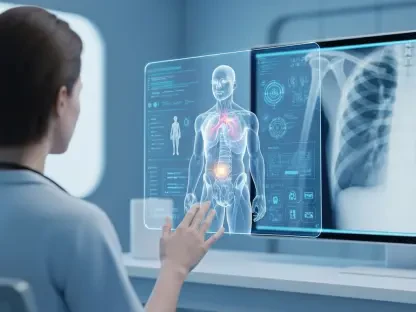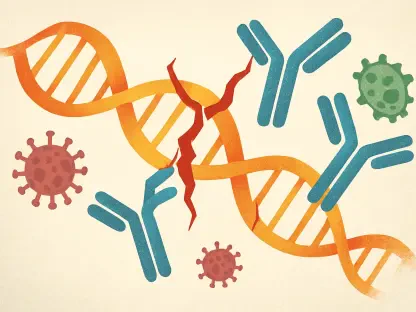What happens when a heart attack strikes, and every tick of the clock could mean the difference between life and death? In emergency rooms worldwide, millions of patients undergo electrocardiograms (ECGs) each year, a test that can reveal a deadly type of heart attack known as ST-segment elevation myocardial infarction (STEMI). Yet, misdiagnosis and delays often cost precious minutes—or lives. Now, artificial intelligence (AI) steps into this high-stakes arena, promising to transform how these critical conditions are detected. Could a machine outpace human expertise in spotting a heart attack before it’s too late?
The significance of this development cannot be overstated. STEMI, caused by a blocked coronary artery, demands rapid intervention to restore blood flow, ideally within 90 minutes. Failure to act in time triples mortality rates, a grim reality for many, especially in rural or under-equipped hospitals. AI’s potential to analyze ECGs with unprecedented speed and accuracy offers a glimmer of hope, cutting through diagnostic errors and ensuring patients get to specialized care faster. This technology could redefine emergency cardiology, saving countless lives by bridging critical gaps in triage and treatment.
The Urgency of STEMI: A Battle Against Time
In the chaos of an emergency, STEMI detection is a race where delays can be fatal. When blood flow isn’t restored through procedures like percutaneous coronary intervention (PCI) within the critical window, the heart muscle suffers irreversible damage. Studies show that exceeding the 90-minute guideline for reperfusion increases death rates dramatically, a challenge compounded by limited access to specialized centers in many regions.
Misdiagnosis adds another layer of complexity. Traditional triage methods often lead to false positives, triggering unnecessary activations of emergency teams, or worse, false negatives that delay life-saving care. In non-PCI hospitals, where expertise and resources are scarce, these errors are even more common. The sheer volume of ECGs performed annually—millions globally—underscores the desperate need for a reliable, rapid solution to streamline this process.
AI’s Game-Changing Role in ECG Interpretation
Enter a groundbreaking AI model, dubbed the STEMI AI ECG Model (Queen of Hearts), which has shown remarkable promise in redefining heart attack detection. A recent study conducted across three U.S. PCI centers between 2025 and 2027 analyzed 1,032 patients with suspected STEMI. The results were striking: of 601 confirmed cases, the AI identified 553 on the initial ECG, far surpassing the 427 detected by standard methods.
Beyond sheer detection, the model slashed false positives from a staggering 41.8% under conventional triage to just 7.9%—a fivefold improvement. This precision means fewer wasted resources and faster pathways to treatment for those in genuine need. By distinguishing acute coronary occlusion from benign mimics, the AI offers a tool that could transform first-contact care in diverse medical settings.
The implications are profound for emergency response systems. With AI, paramedics and clinicians at non-specialized facilities could make critical decisions with greater confidence, ensuring patients are routed to PCI centers without delay. This technology isn’t just a gadget; it’s a potential lifeline for those caught in the critical early moments of a heart attack.
Expert Insights: Hope and Caution in Equal Measure
Voices from the medical field reflect both excitement and measured skepticism about AI’s role in STEMI care. Lead researcher Robert Herman, MD, PhD, from AZORG Hospital in Belgium, describes the model as “a pivotal step toward faster, more precise STEMI care.” His enthusiasm is echoed by senior author Timothy D. Henry, MD, FACC, from The Christ Hospital in Cincinnati, who notes, “This technology could optimize transfers from non-PCI centers, ensuring patients get to the right place at the right time.”
However, not all feedback is unreservedly positive. Mohamad Alkhouli, MD, MBA, from the Mayo Clinic, offers a sobering perspective, pointing out that the AI wasn’t originally designed for STEMI-specific detection. In a recent commentary, he stressed the need for broader testing across varied populations, warning against over-reliance on tech in high-pressure scenarios. His view underscores a key point: AI must support, not supplant, human judgment in life-or-death decisions.
This balance of optimism and caution paints a realistic picture of AI’s place in medicine. While the potential to save lives is clear, the path forward requires rigorous validation and a commitment to integrating technology thoughtfully into clinical workflows. Experts agree that the stakes are too high for anything less.
Real-World Impact: AI in Action
Consider a rural hospital with no on-site cardiologist, where a patient arrives with chest pain. In the past, an ambiguous ECG might have delayed a transfer to a PCI center, risking catastrophic outcomes. With AI-enhanced ECG analysis, the same hospital could now flag a true STEMI in seconds, initiating a rapid transfer and shaving off vital minutes from the treatment timeline.
Such scenarios are no longer hypothetical. Hospitals adopting AI tools have reported smoother triage processes, especially in high-risk areas where delays are common. The ability to prioritize true emergencies over false alarms not only saves lives but also reduces strain on overtaxed emergency systems, allowing resources to be allocated where they’re needed most.
Yet, challenges remain in scaling this technology. Not every facility has the infrastructure or training to implement AI seamlessly. Bridging this gap will require targeted efforts to equip underserved regions with the tools and knowledge to leverage such innovations, ensuring that geographic disparities don’t undermine the promise of better care.
Blueprint for Change: Integrating AI into Emergency Care
Turning AI’s potential into tangible results demands a clear strategy for adoption. Hospitals must train emergency staff to use models like Queen of Hearts as a primary triage tool, focusing on swift identification of STEMI cases during initial patient assessments. This approach could redefine how first responders and clinicians tackle suspected heart attacks.
Deployment should prioritize non-PCI and rural facilities, where delays in care are most pronounced. By embedding AI in these settings, patients can be transferred to specialized centers more efficiently, bypassing the bottlenecks that often lead to tragic outcomes. This targeted rollout could address systemic inequities in access to timely treatment.
Finally, continuous validation is essential. Protocols must be established to monitor AI performance against real-world outcomes, adapting to diverse patient demographics and addressing any limitations. This ongoing scrutiny ensures that the technology remains a reliable ally, enhancing patient safety while easing the burden on emergency teams striving to beat the clock.
In reflecting on this transformative journey, it is evident that AI has opened a new chapter in emergency cardiology. The remarkable strides made in detecting STEMI through ECG analysis have already begun to reshape how clinicians approach life-threatening heart conditions. Looking back, the path to integration has been paved with both innovation and caution, a testament to the medical community’s dedication to precision and care. Moving forward, the focus shifts to expanding access to this technology, ensuring that every hospital, regardless of location or resources, can harness AI to save lives. The next steps involve collaborative efforts to refine, validate, and deploy these tools, promising a future where no patient is left waiting in the critical moments of a heart attack.









